AN ARTIST, LITTLE KNOWN EVEN TODAY...
After Shirley Hicks, I was wondering what I would see next. I looked up the exhibitions on at the Modern Art Museum and hesitated. Jean Fautrier. I knew his work - rather I thought I knew his work - liked it, but would I learn anything new? Then something caught my eye. This exhibition which is to be one of the largest of his retrospectives. (Once again, I get sick of those statements.) But this was to include some 200 works – close to 160 paintings, drawings and prints, and a substantial group of sculptures – from numerous public and private collections in France and abroad. The Musée d’Art Moderne now has the largest Fautrier collection of any museum. Perhaps I would see a lot that I didn’t know.
He was a solitary figure but today considered to be the precursor of Informal art in 1928 and a major contributor to the renewal of modern art after cubism. That I certainly did not know. Another point too.
Jean Fautrier is intimately connected to the history of the Musée d'Art Moderne's collection and its programming. In 1964 the museum presented his first retrospective, organised in close collaboration with the artist following his large-scale donation. In 1989 a second retrospective shed fresh light on a rich, varied and a distinctive oeuvre.
Fautrier's career began in 1920. His painting, figurative at the time, was made up of still lives, landscapes and nudes in styles ranging from a harsh, hallucinatory realism to darkly lit near-abstract shapes.
These were works I knew nothing about at all.
What was unusual about Fautrier is that he did have a brief period of recognition. Unusual becase it was so brief. However, the economic slump ultimately put an end to his artistic career. He was forced to leave Paris in the early 1930s and lived in the Alps for several years, working as a ski instructor and manager of a hotel with its own dance hall. He did of course go on working. This was called his « black period » (1926-1927). A very brutal representation of a subject, accentuated by what seemed to be a delicate brushwork of colour against the dark monochrome canvas. I guess this was a definition of the reality in the world at that time. There were the « black nudes » too in which I found a certain eroticism …
There was a new departure in 1928. What was called his « grey period ». His paintings seemed to become clearer, freer and the subject took second place. These were landscapes which I could cope with and found exciting.
Suddenly there is change again. Illustrations for Dante’s « Inferno ». He was asked by André Malraux to collaborate with the Gallimard Editions to illustrate the text. Finally it was abandoned as the paintings were too abstract. It was here too that I began to recognise works I knew. However, they had never been related to the « Inferno » text. I admit that I have never read it.
Periods of transition followed. It was not surprising that there was a crash in the art market around 1929. Although Fautrier has enjoyed a certain success and lived in reasonably good conditions. This all changed - and the period becomes « black again »
If anything, it is the latter part of his career that I enjoy the most. 1955-1963 and some earlier that that. I like his abstract design. Now he seemed to be painting with a great deal of liberty and enjoyment. But where the titles really necessary ?
1960 saw him acclaimed at the Venice Biennale, where he shared the Grand Prize for Painting with Hans Hartung. Jean Fautrier died during the summer of 1964, just after his first retrospective at the Musée d’Art moderne de la Ville de Paris.
He was a solitary figure but today considered to be the precursor of Informal art in 1928 and a major contributor to the renewal of modern art after cubism. That I certainly did not know. Another point too.
Jean Fautrier is intimately connected to the history of the Musée d'Art Moderne's collection and its programming. In 1964 the museum presented his first retrospective, organised in close collaboration with the artist following his large-scale donation. In 1989 a second retrospective shed fresh light on a rich, varied and a distinctive oeuvre.
Fautrier's career began in 1920. His painting, figurative at the time, was made up of still lives, landscapes and nudes in styles ranging from a harsh, hallucinatory realism to darkly lit near-abstract shapes.
These were works I knew nothing about at all.
 |
| Three Old Ladies -1923 |
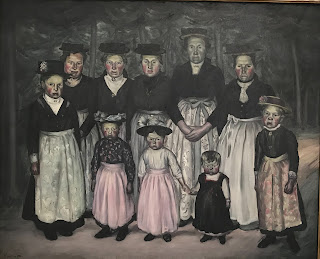 |
| Walk on a Sunday in the Tyrol in our Sunday Best - 1921-22 |
 |
| Portrait of my concierge - 1922 |
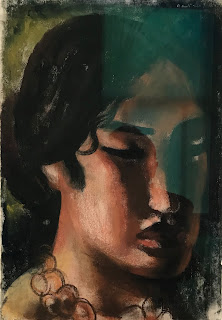 |
| Girl wih closed eyes - 1925-26 |
 |
| Head of a woman in a brothel - 1923 |
 |
| Iceberg 1- 1926 |
 |
| Blue Lake 1 - 1926 |
 |
| Blue Lake 2 - 1926 |
 |
| Bouquet of Lilies - 1926 |
 |
| Bouquet of Black Flowers - 1926 |
 |
| Roses 1 - 1929 |
 |
| The Big Black Boar - 1926 |
 |
| The Duck ot the Green Neck - 1928 |
 |
| Small Nude - 1926 |
 |
| Profile - 1927 |
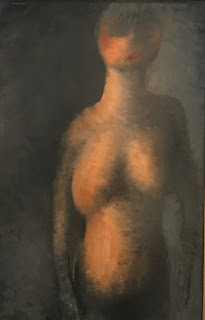 |
| Grey Nude - 1926-27 |
 |
| Christ on the Cross - 1927 |
 |
| Woman's Head - 1928 |
 |
| Nude front on - 1928 |
 |
| Mariette - 1929 |
 |
| Still Life with flowers - 1928 |
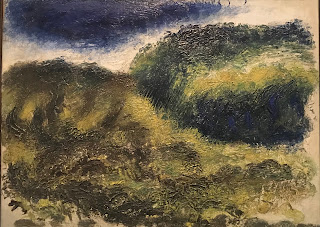 |
| The Forest - 1929 |
 |
| Forest - 1928 |
 |
| Landscape - 1928 |
 |
| Olive Trees - 1929 |
Suddenly there is change again. Illustrations for Dante’s « Inferno ». He was asked by André Malraux to collaborate with the Gallimard Editions to illustrate the text. Finally it was abandoned as the paintings were too abstract. It was here too that I began to recognise works I knew. However, they had never been related to the « Inferno » text. I admit that I have never read it.
 |
| "Inferno" Song XXX - 1930 |
 |
| "Inferno" -1930 |
 |
| "Inferno" -1930 |
 |
| "Inferno" -1930 |
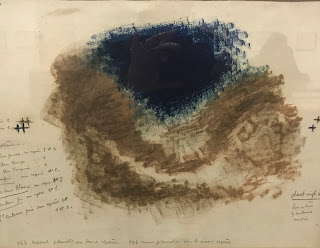 |
| "Inferno" -1930 |
 |
| "Inferno" -1930 |
 |
| Mask of a young girl - 1928 (plaster) |
 |
| Mask of a young girl - 1928 (bronze) |
 |
| Bust with breasts - 1929 |
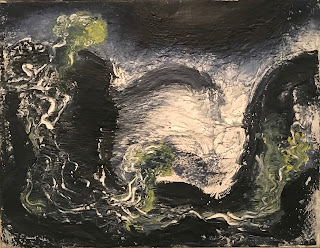 |
| Study of landscape for hell - 192 |
 |
| Entertainment - 1963 |
 |
| Moana - 1959 |
 |
| Green Trees - 1958 |
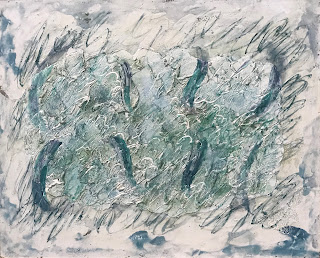 |
| Landscape - 1955 |
 |
| Frozen Lakes - 1956 |
 |
| Garrigue- 1956 |
 |
| Plants - 1957 |
 |
| Peat Moss - 1959 |
 |
| Johanna - 1957 |
 |
| Milwaukee ll - 1962 |
 |
| Green Trees - 1958 |
 |
| His little heart (naked) - 1963 |
 |
| Landscape with three trees - 1928 |
 |
| The Valley - 1936 |
 |
| Head of a Hostage n° 22- 1944 |
 |
| Head - 1954 |
 |
| Sunset in Alabama - 19 |
 |
| Head of a Partisan, Budapest - 1957 |
 |
| The Colander - 1955 |
 |
| The Spool - 1954 |
 |
| The three heads - 1954 |
 |
| The Unhappy Man - 1947 |
 |
| The café grinder - 1947 |
 |
| The carboard Box - 1947 |
 |
| The Spools - 1947 |
 |
| Fêtes - 1947 |
 |
| Photomaton - Faurtier enraged - 1949 |
 |
| Nude - 1957 |
 |
| Glasses - 1946 |
 |
| Canned goods - 1947 |



Commentaires